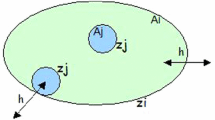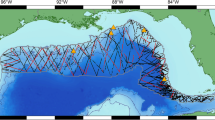Abstract
We consider modeling and prediction of Capelin distribution in the Barents Sea based on zero-inflated count observation data that vary continuously over a specified survey region. The model is a mixture of two components; a one-point distribution at the origin and a Poisson distribution with spatio-temporal intensity, where both intensity and mixing proportions are modeled by some auxiliary variables and unobserved spatio-temporal effects. The spatio-temporal effects are modeled by a dynamic linear model combined with the predictive Gaussian process. We develop an efficient posterior computational algorithm for the model using a data augmentation strategy. The performance of the proposed model is demonstrated through simulation studies, and an application to the number of Capelin caught in the Barents Sea from 2014 to 2019.







Similar content being viewed by others
References
Banerjee, S., Carlin, B. P., & Gelfand, A. E. (2014). Hierarchical modeling and analysis for spatial data. CRC Press.
Banerjee, S., Gelfand, A. E., Finley, A. O., & Sang, H. (2008). Gaussian predictive process models for large spatial data sets. Journal of the Royal Statistical Society: Series B (Statistical Methodology), 70(4), 825–848.
Bradley, J. R., Holan, S. H., & Wikle, C. K. (2018). Computationally efficient multivariate spatio-temporal models for high-dimensional count-valued data (with discussion). Bayesian Analysis, 13, 253–310.
Bradley, J. R., Holan, S. H., & Wikle, C. K. (2020). Bayesian hierarchical models with conjugate full-conditional distributions for dependent data from the natural exponential family. Journal of the American Statistical Association, 115(532), 2037–2052.
Carson, S., Shackell, N., & Mills Flemming, J. (2017). Local overfishing may be avoided by examining parameters of a spatio-temporal model. PLoS ONE, 12(9), e0184427.
Dalpadado, P., Arrigo, K. R., van Dijken, G. L., Skjoldal, H. R., Bagøien, E., Dolgov, A. V., Prokopchuk, I. P., & Sperfeld, E. (2020). Climate effects on temporal and spatial dynamics of phytoplankton and zooplankton in the Barents Sea. Progress in Oceanography, 185, 102320.
Datta, A., Banerjee, S., Finley, A. O., & Gelfand, A. E. (2016). Hierarchical nearest-neighbor Gaussian process models for large geostatistical datasets. Journal of the American Statistical Association, 111(514), 800–812.
Diggle, P. J., Tawn, J. A., & Moyeed, R. A. (1998). Model-based geostatistics. Journal of the Royal Statistical Society: Series C (Applied Statistics), 47(3), 299–350.
Fall, J., Ciannelli, L., Skaret, G., & Johannesen, E. (2018). Seasonal dynamics of spatial distributions and overlap between Northeast Arctic cod (Gadus morhua) and capelin (Mallotus villosus) in the Barents Sea. PLoS ONE, 13(10), 102320.
Gelfand, A. E., & Ghosh, S. K. (1998). Model choice: A minimum posterior predictive loss approach. Biometrika, 85(1), 1–11.
Ghosal, S., Lau, T. S., Gaskins, J., & Kong, M. (2020). A hierarchical mixed effect hurdle model for spatiotemporal count data and its application to identifying factors impacting health professional shortages. Journal of the Royal Statistical Society: Series C (Applied Statistics), 69(5), 1121–1144.
Gjøsæter, H., Bogstad, B., & Tjelmeland, S. (2002). Assessment methodology for Barents Sea capelin, Mallotus villosus (Müller). ICES Journal of Marine Science, 59(5), 1086–1095.
Glynn, C., Tokdar, S. T., Howard, B., & Banks, B. L. (2019). Bayesian analysis of dynamic linear topic models. Bayesian Analysis, 14, 53–80.
Hamura, Y., Irie, K., & Sugasawa, S. (2021). Robust hierarchical modeling of counts under zero-inflation and outliers. Preprint ar**v:2106.10503.
Ingvaldsen, R. B., & Gjøsæter, H. (2013). Responses in spatial distribution of Barents Sea capelin to changes in stock size, ocean temperature and ice cover. Marine Biology Research, 9(9), 867–877.
Jourdain, N., Fuglebakk, E., & Subbey, S. (2021). Maturation in the Barents sea capelin-contrasting length-and gonad-based metrics. Fisheries Research, 237, 105880.
Kelsall, J., & Wakefield, J. (2002). Modeling spatial variation in disease risk: A geostatistical approach. Journal of the American Statistical Association, 97(459), 692–701.
Neelon, B. (2018). Bayesian zero-inflated negative binomial regression based on polya-gamma mixtures. Bayesian Analysis, 14, 829.
Neelon, B., Chang, H. H., Ling, Q., & Hastings, N. S. (2016). Spatiotemporal hurdle models for zero-inflated count data: Exploring trends in emergency department visits. Statistical Methods in Medical Research, 6, 2558–2576.
Polson, N. G., Scott, J. G., & Windle, J. S. (2013). Bayesian inference for logistic models using polya-gamma latent variables. Journal of the American Statistical Association, 108, 1339–1349.
Rue, H., Martino, S., & Chopin, N. (2009). Approximate Bayesian inference for latent gaussian models by using integrated nested Laplace approximations. Journal of the Royal Statistical Society: Series B (Statistical Methodology), 71(2), 319–392.
Stein, M. L. (2014). Limitations on low rank approximations for covariance matrices of spatial data. Spatial Statistics, 8, 1–19.
Torabi, M. (2017). Zero-inflated spatio-temporal models for disease map**. Biometrical Journal, 59(3), 430–444.
Ver Hoef, J. M., & Jansen, J. K. (2007). Space-time zero-inflated count models of harbor seals. Environmetrics: The Official Journal of the International Environmetrics Society, 18(7), 697–712.
Wang, X., Chen, M., Kuo, R. C., & Dey, D. K. (2015). Bayesian spatial–temporal modeling of ecological zero-inflated count data. Statistica Sinica, 25, 189–204.
Acknowledgements
S. Sugasawa is supported by Japan Society for Promotion of Science (KAKENHI) under Grant Nos. 18H03628, 20H00080, and 21H00699. T. Nakagawa is supported by Japan Society for Promotion of Science (KAKENHI) under Grant Nos. 19K14597 and 21H00699. S. Subbey and H. K. Solvang have been supported by Grants 84126—Management Strategy for the Barents Sea, and GA19-NOR-081 from the Sasakawa foundation (Norway).
Author information
Authors and Affiliations
Corresponding author
Ethics declarations
Conflict of interest
On behalf of all the authors, the corresponding author states that there is no conflict of interest.
Additional information
Publisher's Note
Springer Nature remains neutral with regard to jurisdictional claims in published maps and institutional affiliations.
Rights and permissions
Springer Nature or its licensor (e.g. a society or other partner) holds exclusive rights to this article under a publishing agreement with the author(s) or other rightsholder(s); author self-archiving of the accepted manuscript version of this article is solely governed by the terms of such publishing agreement and applicable law.
About this article
Cite this article
Sugasawa, S., Nakagawa, T., Solvang, H.K. et al. Dynamic spatio-temporal zero-inflated Poisson models for predicting capelin distribution in the Barents Sea. Jpn J Stat Data Sci 6, 1–20 (2023). https://doi.org/10.1007/s42081-022-00183-x
Received:
Revised:
Accepted:
Published:
Issue Date:
DOI: https://doi.org/10.1007/s42081-022-00183-x




